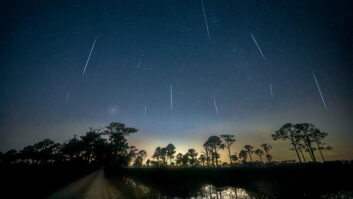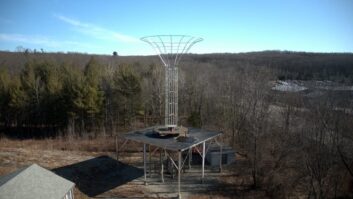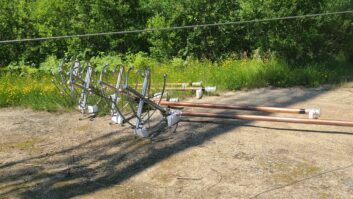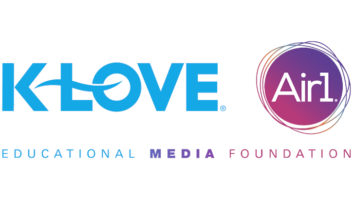The Other Antenna
Oct 1, 2008 12:00 PM, By Doug Irwin, CPBE AMD
Trends in Technology usually covers new technologies and how to make use of them in our broadcast facilities. Still, it’s worthwhile upon occasion to look at more common technologies to see what the most up-to-date products are and how they relate to common applications. This article is about antennas we don’t commonly think of for broadcast transmission.
Application 1: off-air reception

The Kathrein/Scala CLFM is a log-periodic covering the entire FM band.
There are many reasons you may need to improve or otherwise change off-air reception at your studio facility: Perhaps you’ve been made into a cluster with another transmitter site in a different direction; perhaps you are assembling a new facility all together; or perhaps you want to add something as simple as TV reception. (After all, what jock doesn’t like TV in the studio?)
The best kind of receive antenna for off-air reception is one with good directionality and some amount of gain. The reasons are simple: mitigation of multipath. The directional characteristics of most yagi-type or log-periodic types of antennas have very high front-to-side ratios and front-to-back ratios. This means they effectively reject signals that intercept that antenna from its side or back. When you orient this type of antenna at your transmitter site, you emphasize the signal coming from that direction, while de-emphasizing signals coming from all other directions � and that includes multi-path reflections.

Kathrein/Scala’s YA7-FM can be mounted in either polarity, but has less front-to-back or front-to-side ration than the CLFM.
Probably the most well-known manufacturer of antennas for this application is Kathrein/Scala. If you have the space and a strong enough mount on the top of your building then you may want to consider the CLFM, which is a log-periodic covering the entire FM band with 7dB of gain over a dipole, and a front-to-back ration of 25dB (front to side even higher). It comes in 50? and 75? versions, and can be mounted in either horizontal or vertical polarity. If space is a consideration you may want to go with the YA7-FM instead. This antenna has the same gain as the CLFM but not nearly as good of a front-to-back or front-to-side ration. The YA-7FM can also be mounted in either polarity.
For off-air TV reception you may also want to consider Kathrein/Scala. For low-band VHF, consider the CL-26HCM (channels 2 through 6); the HDCA-10 (channels 2 through 13) or the CL-1469 for the entire UHF band.

Kathrein/Scala CL-26HCM for low-band VHF reception, channels 2 through 6.
After you install the antenna and orient it correctly the last thing you want to do is to run low-quality coax to the receiver(s). By low-quality I mean cable with excessive loss and/or poor shielding characteristics. (Remember this is a critical application that will hopefully only be installed once and provide years of service.) One possibility is Belden 1694A. This is for 75? applications, and you would need to choose the black (PVC) jacket for outdoor applications. Another possibility is from a company you should know about if you don’t already: Times Microwave. Its cable for this application would be LMR-400-75. Both of these cables exhibit low-loss and better than 90dB of shielding.
The Other Antenna
Oct 1, 2008 12:00 PM, By Doug Irwin, CPBE AMD

The Kathrein/Scala HDCA-10 is a low-band VHF receive antenna covering channels 2-13.
Once you have delivered those off-air signals to your technical center, you’ll likely have to split them in some way. (After all, you probably have multiple stations and you may have an HD Radio station or two or three.) Resist the temptation to use multiple BNC tees to split that signal. Instead, investigate the product line from Mini-circuits. Mini-circuits makes a wide line of passive RF power dividers: You decide on the number of output ports, the impedance of those ports and the connector type.
The cool thing about these passive power dividers is that you can also use them to add RF signals together. Just keep in mind that they exhibit the same loss whether or not you use them to divide or add signals. (For example, a four-way divider has slightly more than 6dB loss per port; if you use them to add RF signals, each signal going from output to input will still be weaker by 6dB).
Likely you will need a receive antenna to capture the National Weather Service or other VHF/public service channels. At least a couple of good options exist. You could consider the Kathrein/Scala K51262 or a Marti Electronics NMO-150K.
Application 2: Studio-to-transmitter link
Hopefully your facility has 950MHz band aural facility licenses. If so, you have quite a few options available to you as far as antenna suppliers go. One manufacturer practically camouflaged by name changes is now known as Gabriel (formerly Mark or Mark/CSI). Its standard products have been the 4′, 6′ and 8′ grid-dishes (model numbers P-9A48GNU, P-9A72GNU and P-9A96GNU respectively). Marti electronics offers the SC-48, another 4-foot fully parabolic grid-dish. If you have a shorter hop or less of a need for the high amount of directionality afforded by the fully-parabolic antennas you could consider the Kathrein/Scala antennas: the PR-950B or even the mini-flector (MF950B).

The Kathrein/Scala PR-950B is for those who have a shorter hop or less directionality for a studio-to-transmitter link.
One STL transmitter manufacturer sells a system that makes use of a duplexer, which is basically an array of filters that allows you to use one antenna for both receiving and transmitting. You could run with that same idea: Say for example you want to locate your own 900MHz ISM band transceiver at your transmitter site and another at the studio site. Another idea is the locating of an RPU receiver at your transmitter site, and backhauling the audio of same to your studio via a part 101 radio link. EMR makes duplexers that would allow you to assemble systems such as these: for example, the 66542. (Of course you would need one per end).

The K51262 is Kathrein/Scala’s option for capturing the National Weather Service or other public service channels.
There is much more to this topic though. If you have a cluster of stations, with several licensed STL channels, all pointing at the same target, do you really need a transmit antenna for each? Or, say you make use of a two-hop system with an intermediate point. Are you charged for each antenna separately? If so you may want to consider an STL transmitter combiner. Get to know EMR Corporation. One example of its transmit combiners is the 66522, a two-way combiner. Insertion loss is no more than 2.4dB (make sure you include that loss in your path analysis and on your 601) and minimum transmitter separation is 500kHz.
The Other Antenna
Oct 1, 2008 12:00 PM, By Doug Irwin, CPBE AMD

Andrew’s 19T-2440F-1 is only 15″ in diameter and generates 19dBi of gain.
Maybe you’ve decided to use the 2.4 or 5.8GHz ISM bands to pass data back and forth to the transmitter site. If so I’m going to assume you’re putting together a rugged system, and for that reason you would probably want to at least consider Andrew as your antenna maker. For the 2.4GHz band you could chose the 19T-2440F-1; it’s only 15″ in diameter and generates 19dBi of gain (make sure you adjust your transmitter TPO accordingly). For the 5.8GHz band one option would be the 23T-5800F-1.
Application 3: Remote broadcasting

The 23T-5800F-1 is Andrew’s option for the 5.8GHz band.
Even with the recent proliferation of IP codecs there are still plenty of reasons to talk about the good old-fashioned 450MHz RPU systems.
Most man-made electrical noise is vertically polarized, as it turns out, and most users in the 450MHz RPU band use vertical polarity since it’s just easier. However, if you want to minimize noise pickup and interference from other users, one of the best ways is to use horizontal polarity in your RPU system. Fortunately Marti makes a horizontal, omni-directional antenna that can be used as the base station antenna: the HA450. This antenna comes with 1, 2, 4 or 8 bays. Even at 450MHz the HA450-8 is big: the aperture is 14.5 feet. At the same time, it develops 8.5dB of gain over a dipole. On the transmit end you have lots of choices as well for an antenna, but at least consider the Marti YC series because it develops 10dB of gain, and can be physically oriented in either polarity.

Marti’s YC Series develops 10dB of gain and can be physically oriented in either polarity.
Wireless microphones are a big part of many stations’ remote broadcasts. What better way to mingle in the crowd? There isn’t much you can do about the transmit antenna, since it hangs off the bottom of the handheld mic or is otherwise integrated. All you can really do to optimize performance of a wireless mic system is to increase the antenna gain on the receive antenna. (Avoid using the little antennas that come with the system when you buy it � that is if you want to get out more than about 50′.) Here you have quite a few options. Lectrosonics makes the ALP series. For example, the ALP620 covers the entire 450 to 850MHz band, with a gain over a dipole of 4dB. (Remember that the front-to-side and front-to-back ratios are high on a LPDA such as this; that helps mitigate interference and multi-path effects). Output impedance is 50 ohms. Some stations like to set up wireless systems so their jocks can go way, way out in the crowd, or maybe do spontaneous man-on-the-street segments in front of the station or at some other regular spot. In this event you may want to permanently install an antenna that points at that spot. Consider then something like the Kathrein/Scala CL1469B. This is a fairly large log-periodic antenna, made to be outdoors all of the time. It develops 8dB of gain over a dipole; 50 or 75 ohm versions are both available.
The Other Antenna
Oct 1, 2008 12:00 PM, By Doug Irwin, CPBE AMD

Kathrein/Scala’s CL-1469B is a large log-periodic antenna made to be outdoors permanently.
Perhaps you want to avoid a directional wireless mic antenna � not a bad idea, especially if the venue isn’t really that big. Marti makes a series of verticals that mount to a mic stand � such as the PAV450 (covers up to 480MHz). Even this antenna develops 3dB of gain over a dipole.

Lectrosonics ALP Series including the popular ALP620.
Any RF system that you design and assemble should make use of an antenna optimal for the job. Often times most of the effort placed in an RF system design considers only the gear that lives in the racks; but with any RF system, it’s crucial to pay attention to the mundane details: antenna types, connector types, coax specifications. These items make up a crucial part of any radio station’s infrastructure, and if they are neglected, the system’s performance is bound to be degraded at some point in time, whether from day one or at some point in the future.
Doug Irwin is the chief engineer of WKTU-FM, New York City.







